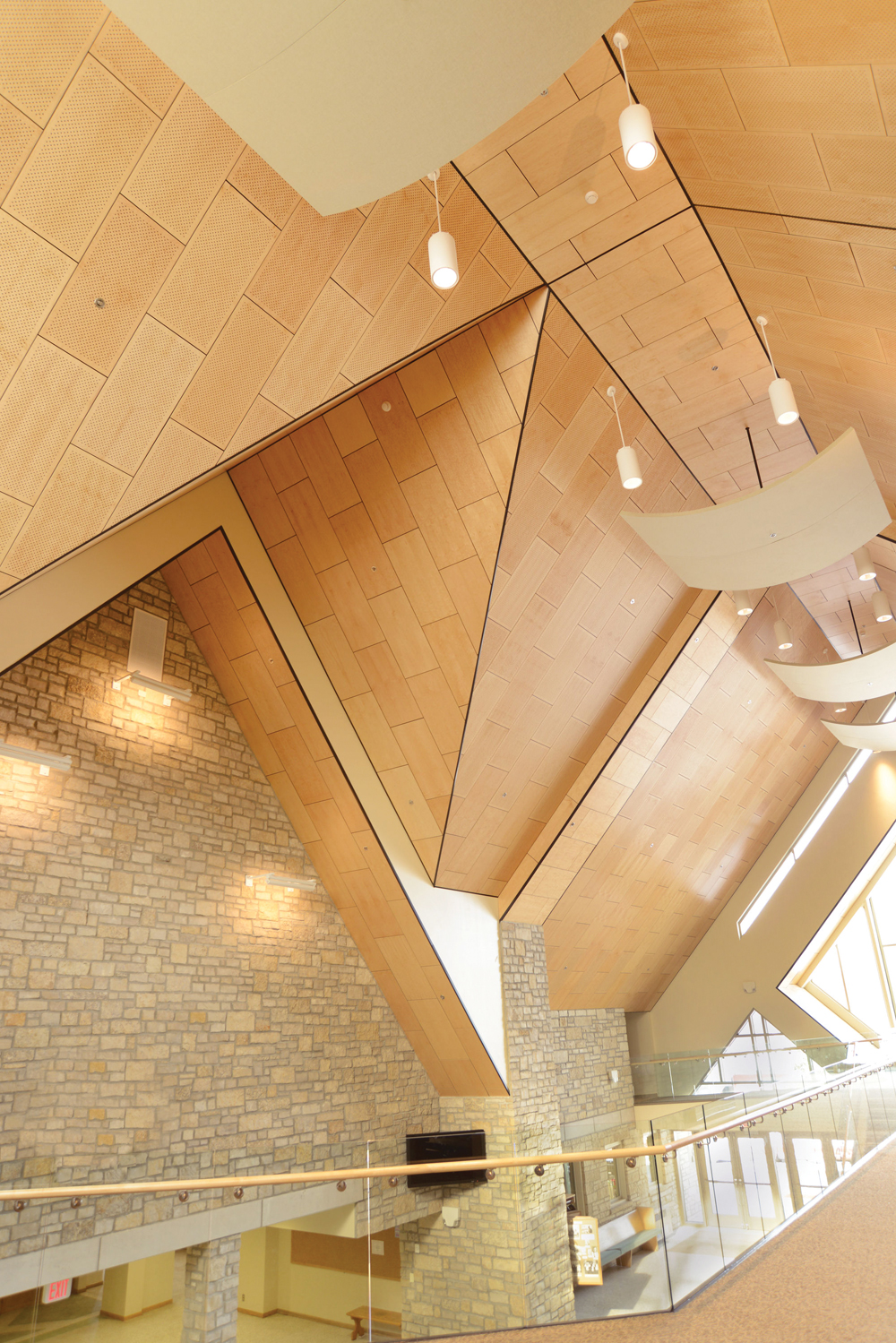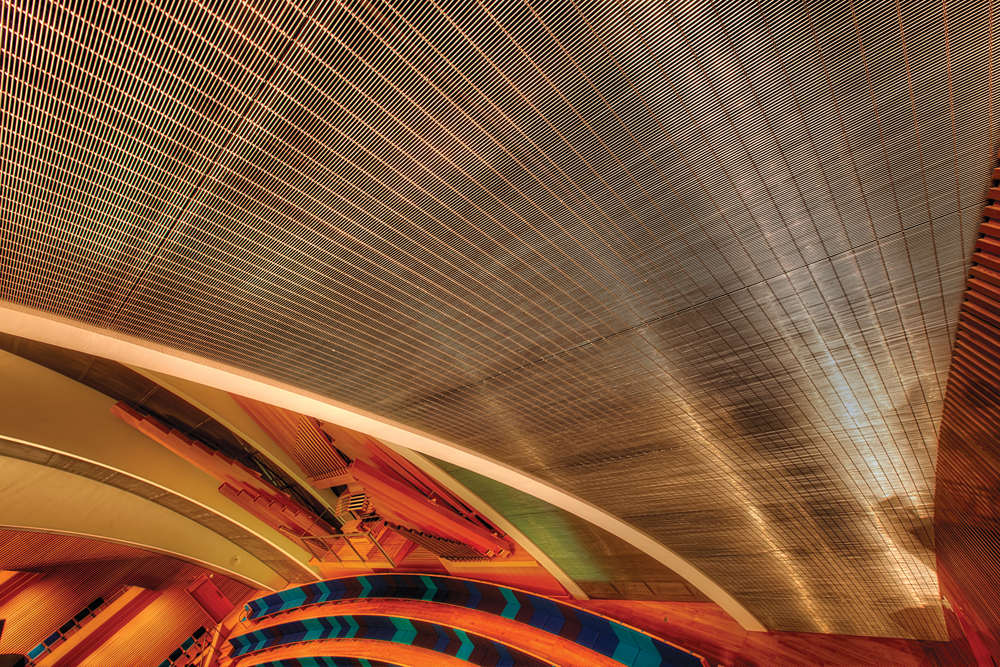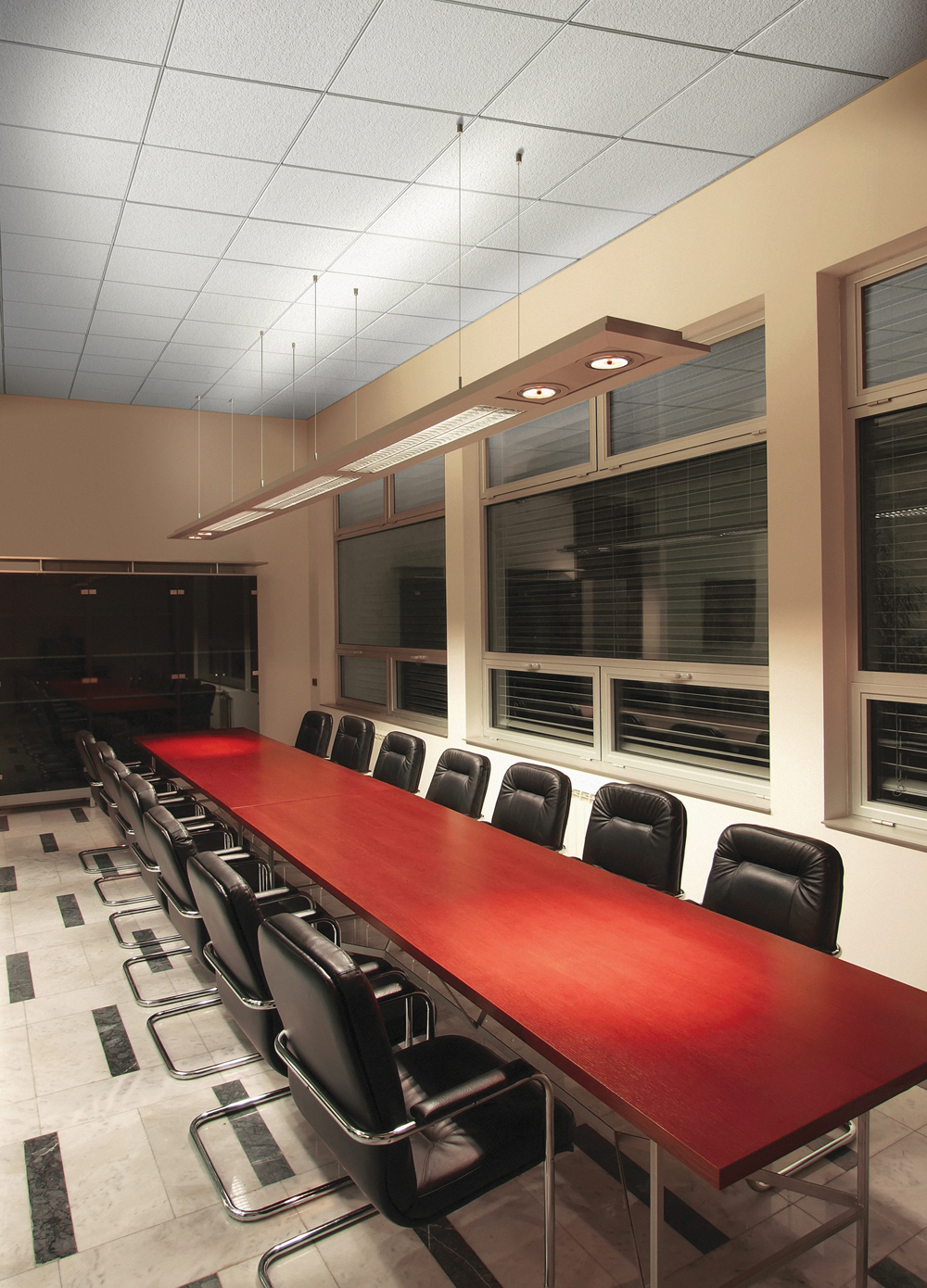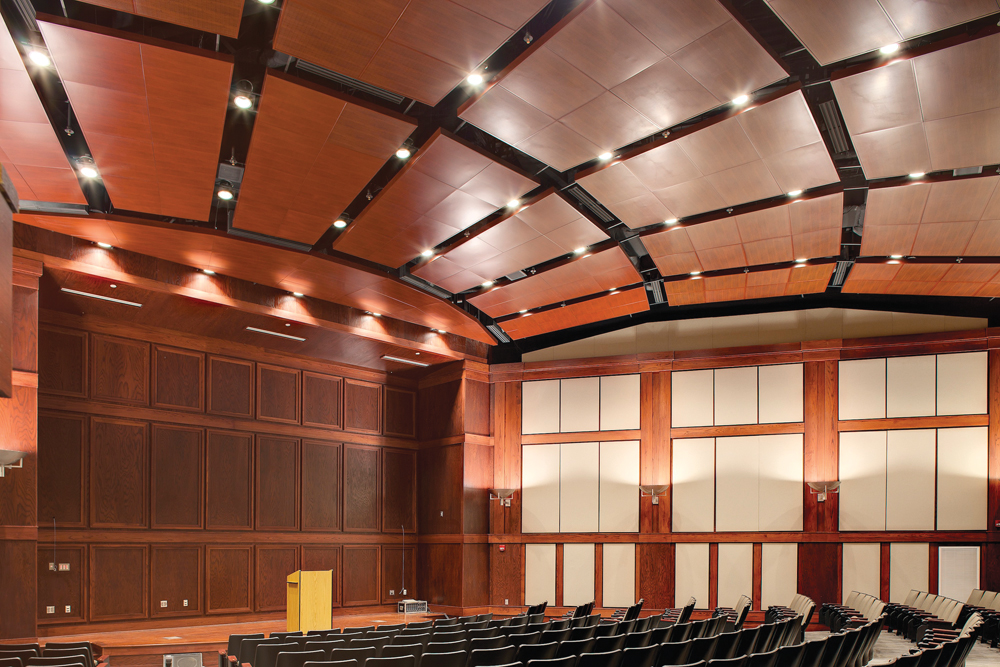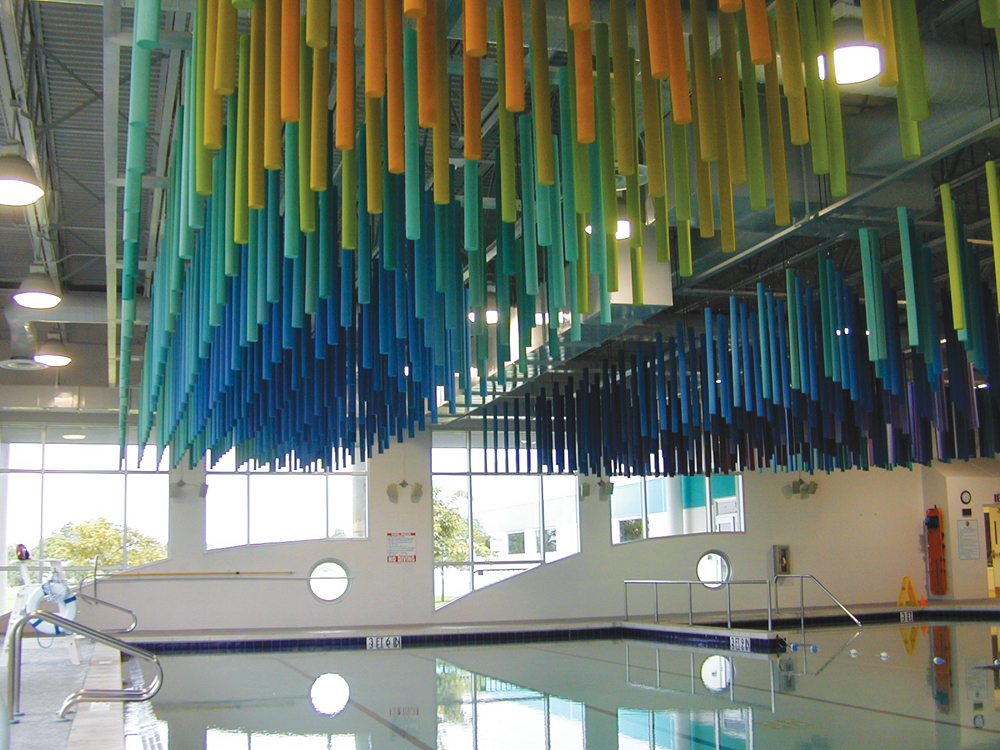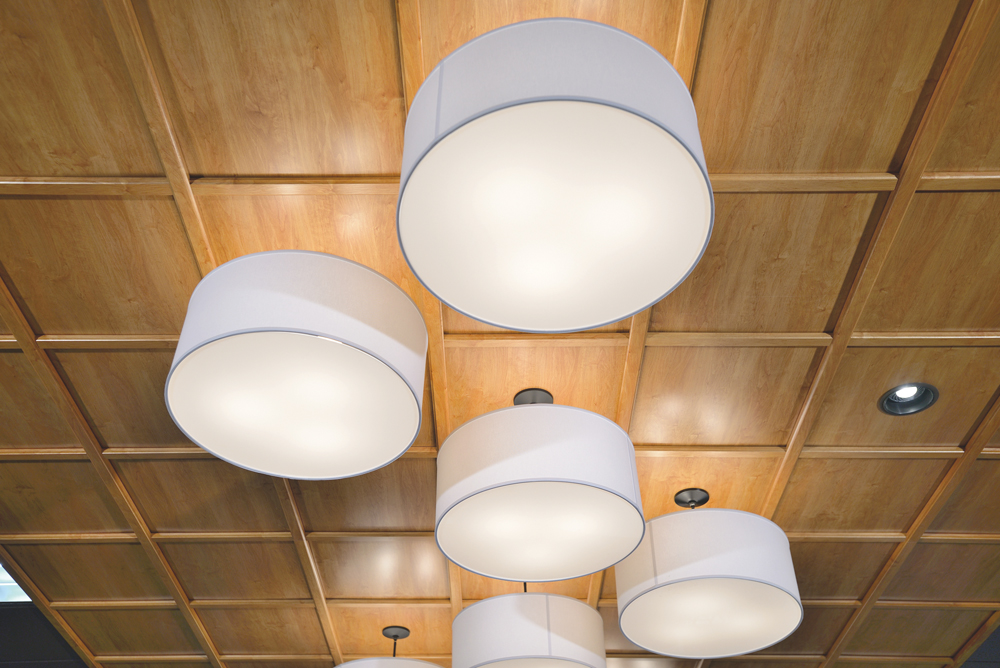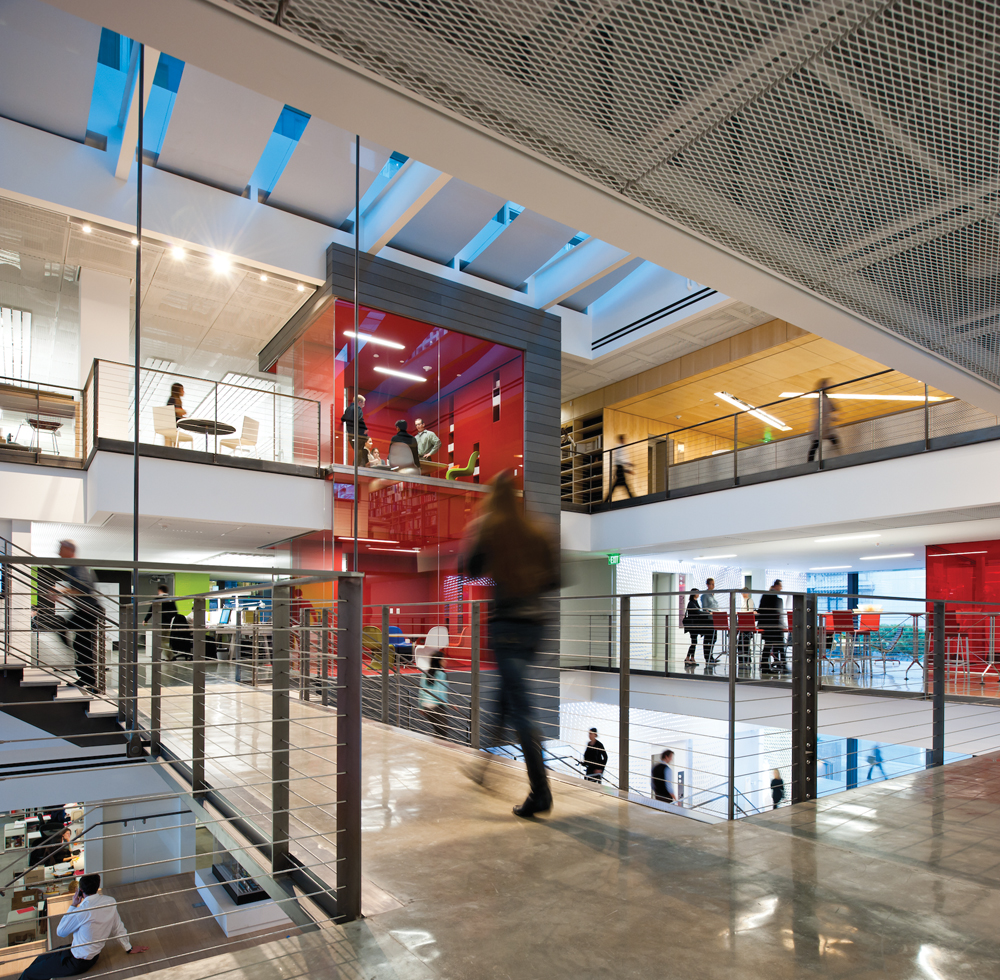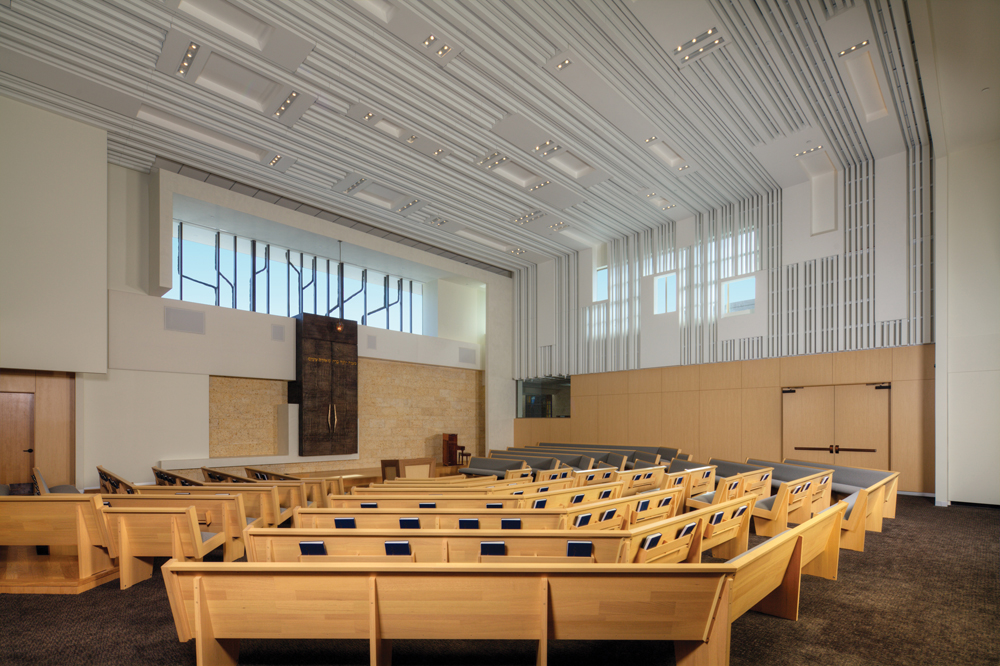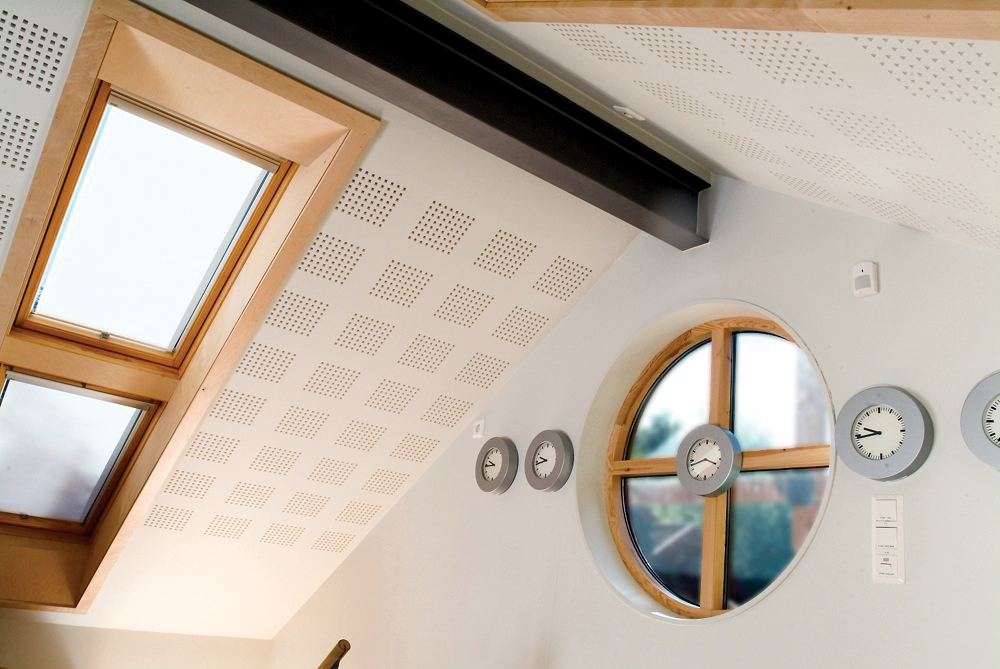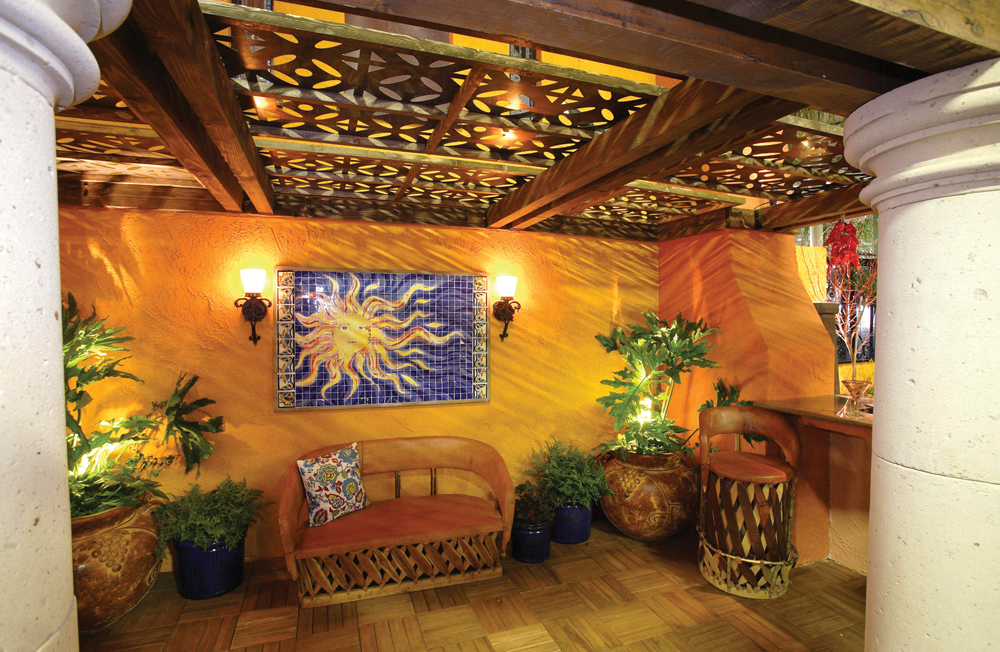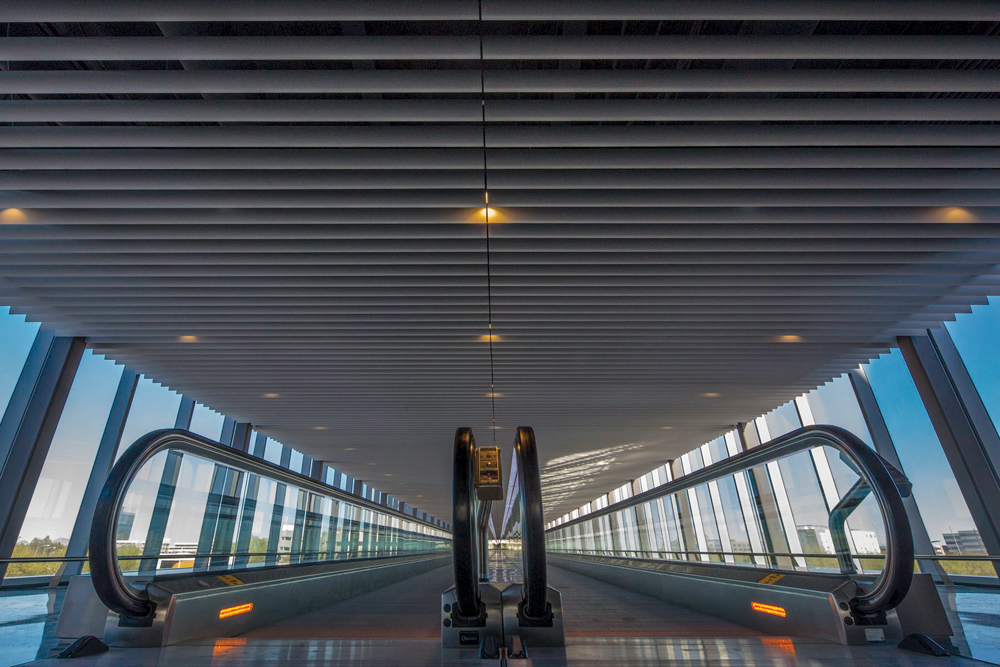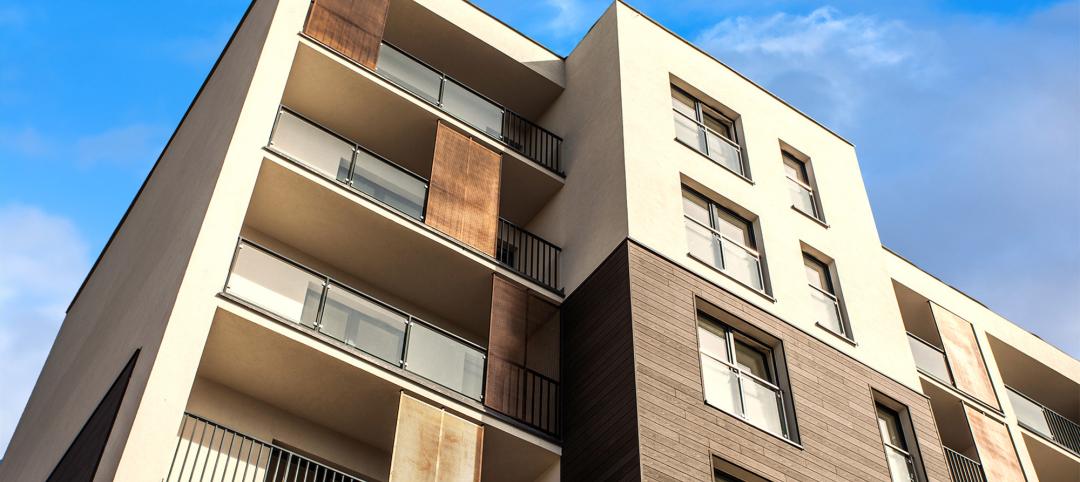From metal mesh panels to concealed-suspension ceilings, here's our roundup of the latest acoustical ceiling and wall products.
1. EXPOSED STRUCTURE ACCOMMODATED BY CONCEALED-SUSPENSION CEILINGS
To improve design flexibility, Armstrong now offers its largest metal ceiling panels in a concealed-suspension system for a cleaner, more monolithic look. New MetalWorks Concealed ceilings feature a narrow quarter-inch reveal and can be installed in standard 15/16-inch suspension systems. The panels can be used to create a continuous ceiling look or a “floating” aesthetic when installed in a ceiling cloud with matching trim. Panels come in five sizes and three factory-applied powder-coated finishes, and in perforated or nonperforated styles. The already high noise-reduction coefficient (0.80) can be increased to 0.95 by backing the perforated panels with BioAcoustic infill.
Armstrong World Industries
2. CHURCH PROJECT BENEFITS FROM WOODEN ACOUSTICAL PANELS
Aesthetic impact and excellent acoustics were high priorities for Trinity Lutheran Church, Owatonna, Minn., when the congregation decided to expand with a large addition. I&S Group and Twin City Acoustics collaborated on the design and installation of WoodTrends Elite acoustical wood ceiling panels in birdseye maple. The panels, consisting of wood over an MDF, chipboard, or plywood substrate, install into a standard 15/16-inch grid, leaving a 3/8-inch reveal. Two coats of clear UV-cured polyacrylate finish enhance the natural grain. In addition to the perforated acoustical product, the church ceiling includes matching unperforated, reflective panels. Depending on perforation pattern, Elite panels offer a noise-reduction coefficient value as high as 0.90.
Sound Seal
3. METAL MESH CEILING SYSTEM OFFERS SLEEK APPEARANCE, ACOUSTICAL PERFORMANCE
Silentmesh is a new multi-layer ceiling system composed of metal fabric and an underlayment of acoustic absorption material. The product is designed to offer a clean, modern aesthetic in a rigid suspension system that can be molded into custom shapes. Composite Mesh Plate technology combines metal fabric with an aluminum honeycomb plate, providing rigidity and long panel spans to minimize the number of seams required.
GKD
4. ACOUSTICAL CEILING PANELS CONTRIBUTE TO LEED RECYCLED-CONTENT CREDIT
Classrooms, lobbies, conference rooms, executive offices, retail stores, and transportation terminals are among the manufacturer-suggested applications for Bria ClimaPlus acoustical ceiling panels. With a noise-reduction coefficient of 0.70, the lightly textured panels have a 30-year system warranty against visible sagging, mold, and mildew. The surface may easily be cleaned with a brush or vacuum. Impact resistance is double that of similarly textured panels tested per ASTM C367. Zero VOC-emitting performance and high recycled content help maximize opportunities for LEED points.
USG Corp.
5. WOOD-LOOK METAL CEILING SYSTEM MEETS GOALS FOR MILITARY AUDITORIUM
The Dannelly Composite Operations and Training Facility of the Alabama Army and Air National Guard, in Selma, has a new 1,800-sf auditorium featuring SpanAir Torsion Spring ceiling panels. The wood-look recycled aluminum product was well-suited to the space’s sporadic occupancy patterns, including times when the HVAC systems are shut down for energy savings. Given the humid climate, the metal panels were a more practical choice than a wood veneer/substrate combination. The custom WoodScenes walnut-painted finish matches trim colors in the client’s existing facilities. Acoustical performance was adjusted with a backer or acoustical blanket according to panel placement in the auditorium space, to maximize sound control. On the Building Team: Seay Seay & Litchfield Architects, Bear Brothers (contractor), and E&E Acoustical and Drywall (installer).
Chicago Metallic
6. RECREATION CENTER SCULPTURE INCORPORATES ACOUSTIC BAFFLES
A high level of background noise often annoys people using public indoor pools. The Betty T. Ferguson Recreation Center Aquatic Facility in Miami Gardens, Fla., addressed this problem by commissioning a sound-dampening sculpture. Artist Xavier Cortada created an overhead installation featuring pinta acoustic’s colorful SONEX Rondo cylinders, made with Basotect sound-dampening melamine foam from BASF. The sculpture, entitled “Splash!,” resembles “noodle” flotation devices often used by young swimmers. SONEX baffles reduce reverberation and echoes in the pool area by absorbing sound across all frequencies. The product resists fungal and microbial growth and can withstand the humid conditions characteristic of indoor natatoriums, according to the manufacturer.
pinta acoustic, BASF
7. WOOD CEILING SYSTEMS ARE FSC CHAIN OF CUSTODY CERTIFIED
WoodTrac ceiling systems are designed to offer the look and feel of custom-crafted wood ceilings at affordable prices. The panels install over a 15/16-inch suspended ceiling grid, allowing them to fit most new or existing systems. Moldings are available in three profiles and are compatible with 2 x 2-foot or 2 x 4-foot ceiling panels. Designers can choose from four stock finishes and more than 20 custom finishes. WoodTrac systems include a Forest Stewardship Council Chain of Custody certification, with all timber harvested from responsibly managed forests.
WoodTrac
8. EXPANDED METAL CEILINGS COMBINE FUNCTIONALITY AND VISUAL APPEAL
Lindner USA’s expanded metal ceilings offer a broad range of design options, including diamond-shaped or square mesh, solid or filigree, and see-through or opaque. The lightweight, sustainably manufactured material can be deployed in lay-in, hook-on, swing-down, or drop-slide configurations, and can easily be combined with light fixtures or other infrastructure, according to the manufacturer. Plafotherm integrated heating and cooling technology expands the range of choices. Custom manufacturing services are available.
Lindner USA
9. WHITE CEILINGS ENHANCE DAYLIGHTING FOR CALIFORNIA TEMPLE RENOVATION
Blanco Mat, a new ceiling product with a brilliantly white finish, creates a dramatic effect in the recently remodeled Temple Israel in Long Beach. The finish optimizes the daylight entering through skylights and high clerestory windows, and its matte surface eliminates glare. Abramson Tieger Architects used linear elements of various depths and widths to create a design inspired by the tallit, a fringed prayer shawl, sheltering and embracing the congregation. Ceilings Plus assembled the elements at the factory, using its Barz panel system to simplify field installation and minimize weight on the existing building’s structure. Also on the Building Team: Elljay Acoustics (installation) and Design Insight (manufacturer’s representative).
Ceilings Plus
10. PERFORATED ACOUSTICAL PANELS ARE SCALED FOR LIGHT-FIXTURE INTEGRATION
The Gyptone BIG line of large-format perforated acoustical panels has been expanded with the launch of Quattro 46, which has a smaller perforated area to make it easier to incorporate linear light fixtures. The perforated panels allow for monolithic ceiling and wall designs without visible breaks or joints, and provide superior acoustics (NRC 0.60) for open lobbies, classrooms, and offices, according to the manufacturer. Quattro 46 panels are made with 80% post-consumer and 5% pre-consumer recycled content, and are fully recyclable at the end of their useful life. The panels are suitable for direct or suspended screw mounting and may be painted with a short-nap roller.
CertainTeed Ceilings
11. DAPPLED LIGHT EFFECTS ACHIEVABLE WITH ARCHITECTURAL PERFORATED PANELS
Parasoleil architectural perforated panels are available in copper, aluminum, steel, wood, and composite materials, and are designed to last at least 30 years. Typical uses include dropped ceilings, canopies, privacy screens, back-lit wall surfaces, railings, and lighting systems, as well as exterior applications such as shades, awnings, and shutters. Many styles of contemporary, traditional, nature-inspired, and culturally inspired patterns are available; the manufacturer also offers customization for design flexibility. Products are made with recycled materials and are recyclable.
Parasoleil
12. CUSTOM BAFFLE CEILING SYSTEM DELIVERS HIGH PERFORMANCE FOR AIRPORT
The new PHX Sky Train at Phoenix Sky Harbor International Airport is an automated system that improves access to parking lots, off-site light rail, and airport terminals. Architect HOK collaborated with subcontractor T-P Acoustics and Hunter Douglas Architectural Products to create the High Profile Series, a new style of acoustic baffle ceiling, for a three-level transit station. Mockups and prototypes helped refine a sliding attachment device compatible with a standard 15/16-inch T-grid.
The sliding feature allows point access for maintenance without requiring baffle lowering or removal. Extruded aluminum baffle profiles were created to span 24-foot widths; the six-inch baffle profile at eight-inch spacing helps mask the plenum for ceilings as high as 40 feet. The project also features the manufacturer’s linear plank ceiling products in an airplane-wing design for the exterior-to-interior transition, and a torsion-spring ceiling to maintain the station’s tubular shape on the second floor. Also on the Building Team: Gannett Fleming (design lead/engineer) and Hensel Phelps (GC).
Hunter Douglas Contract
Related Stories
Mixed-Use | Jan 19, 2024
Trademark secures financing to develop Fort Worth multifamily community
National real estate developer, investor, and operator, Trademark Property Company, has closed on the land and secured the financing for The Vickery, a multifamily-led mixed-use community located on five acres at W. Vickery Boulevard and Hemphill Street overlooking Downtown Fort Worth.
Modular Building | Jan 19, 2024
Building with shipping containers not as eco-friendly as it seems
With millions of shipping containers lying empty at ports around the world, it may seem like repurposing them to construct buildings would be a clear environmental winner. The reality of building with shipping containers is complicated, though, and in many cases isn’t a net-positive for the environment, critics charge, according to a report by NPR's Chloe Veltman.
Sponsored | BD+C University Course | Jan 17, 2024
Waterproofing deep foundations for new construction
This continuing education course, by Walter P Moore's Amos Chan, P.E., BECxP, CxA+BE, covers design considerations for below-grade waterproofing for new construction, the types of below-grade systems available, and specific concerns associated with waterproofing deep foundations.
Sponsored | Performing Arts Centers | Jan 17, 2024
Performance-based facilities for performing arts boost the bottom line
A look at design trends for “budget-wise” performing arts facilities reveals ways in which well-planned and well-built facilities help performers and audiences get the most out of the arts. This continuing education course is worth 1.0 AIA learning unit.
Adaptive Reuse | Jan 12, 2024
Office-to-residential conversions put pressure on curbside management and parking
With many office and commercial buildings being converted to residential use, two important issues—curbside management and parking—are sometimes not given their due attention. Cities need to assess how vehicle storage, bike and bus lanes, and drop-off zones in front of buildings may need to change because of office-to-residential conversions.
MFPRO+ News | Jan 12, 2024
Detroit may tax land more than buildings to spur development of vacant sites
The City of Detroit is considering a revamp of how it taxes property to encourage development of more vacant lots. The land-value tax has rarely been tried in the U.S., but versions of it have been adopted in many other countries.
MFPRO+ News | Jan 12, 2024
As demand rises for EV chargers at multifamily housing properties, options and incentives multiply
As electric vehicle sales continue to increase, more renters are looking for apartments that offer charging options.
Student Housing | Jan 12, 2024
UC Berkeley uses shipping containers to block protestors of student housing project
The University of California at Berkeley took the drastic step of erecting a wall of shipping containers to keep protestors out of a site of a planned student housing complex. The $312 million project would provide badly needed housing at the site of People’s Park.
Apartments | Jan 9, 2024
Apartment developer survey indicates dramatic decrease in starts this year
Over 56 developers, operators, and investors across the country were surveyed in John Burns Research and Consulting's recently-launched Apartment Developer and Investor Survey.
K-12 Schools | Jan 8, 2024
Video: Learn how DLR Group converted two big-box stores into an early education center
Learn how the North Kansas City (Mo.) School District and DLR Group adapted two big-box stores into a 115,000-sf early education center offering services for children with special needs.




